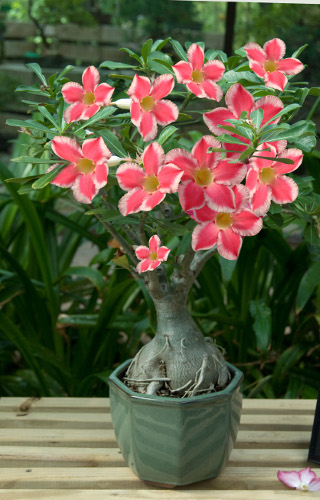We use cookies to make your experience better. To comply with the new e-Privacy directive, we need to ask for your consent to set the cookies. Learn more.
Sabi Star, Kudi, or Gemini Rose

POT SIZE
These plants prefer a shallow and wide pot. Adeniums like pots that allow their soil to dry rapidly and to allow room for their swollen base or caudex to expanc. We recommend an 8 inch ceramic or clay pot that is no deeper than 4 inches (a cactus type pot). They do best in clay or ceramic as opposed to plastic. Try to avoid using a plastic container. When replanting make sure to use a quick draining cactus type potting mix and do not plant deeper than original soil line. Try not to disturb the roots when transplanting. Immediately water your plant until water is seen coming through the bottom of the pot. Please avoid letting a catch dish ever sit with water in it to prevent rotting out.When nights stay above 50 degrees place your plants outside and leave them there all summer long- the hotter the better. They like full sun in the summer though partial sun is fine too. In the winter inside the home, place in sunny location and water only sparingly once every two weeks. Keep away from cold drafts.
SOIL AND FERTILIZATION
Plant using cactus or succulent mix. Otherwise bagged potting mixes for houseplants that will drain well work fine too. Most garden centers carry various brand names with perlite, vermiculite, soil and sand. To promote more flowers use a well balanced fertilizer like Roberta’s Flower Magic Plant Food (M7503) once a week April through October. They enjoy leaf feeding as often as you like.
GARDEN PREPARATION
If you live where it rarely dips below 45 degrees, they may be planted directly into the garden if you live in zones 10-11; this may be done as soon as you’d like. If your soil is clayish amend it with a standard garden soil for adequate drainage. Plant no deeper than the original soil line. Place in a sunny location. It is normal to loose a few leaves the first couple weeks after transplanting.
PLANTING SPACING
Space them 2 to 3 feet apart in the garden.
PLANT HEIGHT AND WIDTH
These can grow 6 inches per year up to 3 feet tall and 1 to 2 feet wide.
WATER
During the summer months when they are outside in the full sun, they need regular watering. With a quick draining potting mix, water the desert rose when the soil feels almost completely dry when you insert your finger into the soil. Water until moisture drips from bottom of the pot and make sure to empty pot’s drip tray after every watering. Indoors in the winter water as if they were delicate, rot- prone cacti during winter. Adeniums are extremely susceptible to rot when watered too frequently during cool weather or if chronically waterlogged at any season. Use of a well-drained potting medium prevents most rotting problems.
FERTILIZER
To promote more flowers use a well balanced fertilizer like Roberta’s Flower Magic Plant Food (M7503) once a week April through October. They enjoy leaf feeding as often as you like.
LIGHTING
Full or partial sun is best in summer. In winter months bright diffused light is more than sufficient.
BLOOMING
These may bloom in summer of first season, but by second season your established desert rose can bloom from summer through to early winter. Although Adenium is a popular houseplant in temperate regions it requires a sunny location outside in summer. When nights stay above 50 degrees place your plants outside and leave them there all summer long- the hotter and sunnier the better. The point is they like a change in day to night temperatures to grow and bloom properly. When temperatures drop below 50 degrees in the autumn, bring your plants inside. If you live where nights rarely drop below 40 to 50 degrees, you can leave your plants outside year round.
WINTER SEASON
In the winter inside the home, water only once sparingly every two weeks.
PRUNING
Little or no pruning is necessary. If you do decide to prune a branch that is too long do so in the spring. The plant will emit a milky sap. Let it callous naturally. Your plant will branch into multiple shoots just below the cut.
FAQ's
DO YOU TREAT LIKE CACTUS?
Adenium obesum, is also known as Sabi Star, Kudu or Desert- rose. It is native to tropical and subtropical eastern and southern Africa and Arabia. While some Adenium do grow in extremely arid deserts, it does not necessarily follow that they need to be wedged in a rock crevice and constantly deprived of water. Many xerophytes evolved from tropical species that adapted to aridity rather than migrated as the forest retreated due to climatic change. Adeniums are apparently among these, and most of the them have not lost their affinity for more moist growing conditions in summer which stimulates their growth a lot.
Water them as if they were coleus or tomato plants while they’re growing in hot weather, but as if they were delicate, rot-prone cacti during winter. Adeniums are extremely susceptible to rot when watered too frequently during cool weather or if chronically waterlogged at any season. Use of a well-drained potting medium prevents most rotting problems.
CAN THEY BE GROWN INSIDE YEAR ROUND?
Although Adenium is a popular houseplant in temperate regions it requires a sunny location outside in summer. When nights stay above 50 degrees place your plants outside and leave them there all summer long- the hotter and sunnier the better. The point is they like a change in day to night temperatures to grow and bloom properly. When temperatures drop below 50 degrees in the autumn, bring your plants inside. If you live where nights rarely drop below 40 to 50 degrees, you can leave your plants outside year round.
WHAT SIZE AND TYPE OF CONTAINER IS BEST?
Adenium like pots that allow their soil to dry rapidly and to allow room for their swollen base or caudex to expand. These plants prefer a shallow pot as opposed to a deep pot. They prefer a wide pot as opposed to a narrow pot. They do best in clay or ceramic as opposed to plastic. Try to avoid letting a catch dish ever sit with water in it to prevent rotting out. It is recommended to use an eight inch wide pot that is no deeper than four inches. This is a typical cactus type pot.
IF A MATURE PLANT SUDDENLY BEGINS TO SHRIVEL AT THE BASE AND LOOSE ITS LEAVES, WHAT WENT WRONG?
More than likely it stayed too wet in cool weather. Try to salvage by making a cutting. Propagation by cutting is easy. Cut end shoots and let dry for a day or two. Dip in rooting hormone if available. Be careful of the sap. Stick shoots into a pot of moist soil, and provide bottom heat from a heat mat. Keep soil slightly moist but not soggy.
Free shipping On all orders!
100% gotta grow Guarantee!
Best prices Online!
24/7 free Online support
